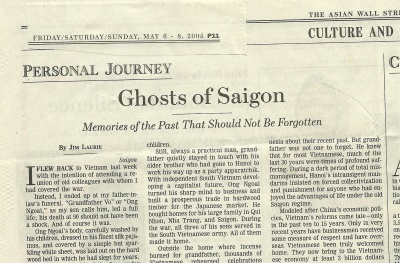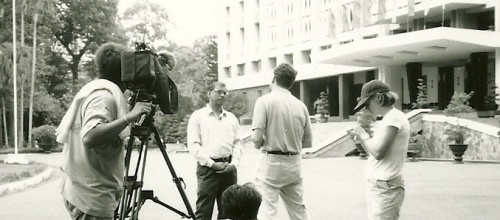|
Vietnam has come to occupy a special place in my career and my personal life. From 2005 a look back at the life of a remarkable Vietnamese man,
Professionally, I have been a witness to events in Vietnam for over four decades: The war from 1970 to 1973. What the Vietnamese called "Giai Phong" in 1975. The reforms or "Doi Moi" from 1988. The development of a major Southeast Asian economic Tiger in the late 1990's into the decade from 2000 to 2010.
Personally, my attachment to Vietnam was deepened when I married Xuan Xanh Vo in 1991. Some of my fondest memories of the country came in 1995, ‘cyclo’ riding my three year old son through the streets of Saigon, and in 2004, relaxing on the pleasant veranda of our French style, An Phu Dong house, south of the city, overlooking the Saigon River.
When my father-in-law died in 2005, it was both an occasion of sadness and reflection on Vietnam as I wrote in the Wall Street Journal.
The article from 6 May 2005 begins:
"I flew back to Vietnam last week with the intention of attending a reunion with old colleagues with whom I had covered the war.
Instead, I ended up at my father-in-laws funeral. "Grandfather Vo" or "Ong Ngoai" as my son calls him, led a full life; his death at 90 should not have been a shock. But of course it was."
The full article is reprinted below:

Ong Nguoi’s body, carefully washed by his children, dressed in his finest silk pajamas, and covered by a simple but sparkling white sheet, was laid out on the hard wood bed in which he had slept for years. The children placed buckets of ice under the bed to keep grandfather cool.
The family gathered in the Saigon house that had been his home since the early 1980’s. They came from everywhere. Some arrived from the CentralCoast – Qui Nhon and Nha Trang. Others, once the refugees of the 70’s and 80’s, flew in from Montreal, Tampa and Los Angeles to pay their respects, to show their love, to say good-byes.
Ong Nguoi willed his body to the Ho Chi Minh CityUniversityMedicalSchool – a thoroughly modern gesture in a very traditional home.
“Let the students learn something from this old corpse – if they can!” he had exclaimed with a hearty laugh to his youngest daughter.
As Ong Nguoi was taken away, my tearful wife cried out: “Father’s spirit is here, I can feel it. He’s watching us. He remains in this house!”
The family quickly assembled a shrine which grew in size day-by-day and drew a parade of tearful mourners who lit incense and prostrated themselves before grandfather’s photo. All seemed persuaded they were in the presence of a powerful spirit from which there was still much to learn.
Ong Nguoi had seen it all. Born in Central Vietnam near Qui Nhon, he joined the Vietminh in the 1930’s to help expel the French from Indochina.
When the French were gone, he refused to join the Viet Cong resistance to the Americans. He had become disillusioned with the communists. In addition, he wanted to provide a good life for a growing family which by 1960 numbered nine children.
Still, always a practical man, grandfather quietly stayed in touch with his older brother who had gone to Hanoi to work his way up as a party apparatchik.
With independent South Vietnam developing a capitalist future, Ong Nguoi turned his sharp mind to business and built a prosperous trade in hardwood timber for the Japanese market. He bought homes for his large family in Qui Nhon, Nha Trang, and Saigon.
In war, three sons served in the South Vietnamese army. All of them made it home.
Outside the home where incense burned for grandfather, thousands of Vietnamese rehearsed celebrations marking the 30th anniversary of the fall of Saigon. They marched about the city centre. This year’s was not like the usual military parades I have watched on past anniversaries. This year thousands of young people, none with any memory of war, assembled a flotilla of floats celebrating commerce, technology, the IT revolution, foreign investment, and tourism.
In front of the old French Opera House, extraordinarily lithe and handsome fashion models strutted around Lam Son Square. Down near Doc Lap (Independence) Palace (renamed Re-unificationPalace by the Communists), an army of young men representing the hotel and restaurant industry shouldered seven foot high papier-mâché forks, knives and spoons.
I imagine Ong Nguoi’s spirit soaring above, observing all this. I can see him stroking his straggly Ho Chi Minh style beard, chuckling at this glorious socialist-capitalist nonsense.
Right up until a week before his death, Grandfather walked the streets of Saigon with a sprightly step. He smiled at the pretty girls in their Ao-dais. He noted the city’s vigor, its renewed prosperity. His children and grandchildren who had fled Vietnam had returned to invest in local business and buy property.
Ong Nguoi also knew that many Vietnamese are afflicted with a collective amnesia about their recent past. Grandfather though was not one to forget.
He knew that for most Vietnamese, much of the last 30 years were times of profound suffering. During a dark period of total mismanagement, Hanoi’s intransigent mandarins insisted on forced collectivization and punishment for anyone who had enjoyed the advantages of life under the old Saigon regime.
Modeled after China’s economic policies, Vietnam’s reforms came late - only in the past ten to 15 years. Only in very recent years have businessmen received some measure of respect and have overseas Vietnamese (Viet Kieu) been truly welcomed home. The Viet Kieu now bring to the Vietnamese economy at least 3 billion dollars each year.
Before 1990, grandfather and other capitalists, their businesses shut down, their properties confiscated, lived as pariahs in Vietnamese society.
Immediately after the fall of Saigon, grandfather, fearing arrest, fled his home and with his youngest son, went into hiding in the forests which for twenty years had supported his timber business. He emerged years later, contacted his brother in Hanoi, and managed to reach an accommodation. By keeping quiet he was spared further reprisals.
By then, his daughter (my wife), and other children had fled the country.
They became part of a flood of boat people which reached a horrible crescendo in the mid 1980’s.
Ong Nguoi’s oldest daughter died a painful death on an Indonesian island after a harrowing boat journey from coastal Vietnam.
As I look back on the 15 years I knew him and the 30 years since I watched North Vietnamese forces capture the city of Saigon, I imagine the spirit of Ong Nguoi hovering above the spectacle of modern Vietnam, urging the young generation not to forget the past.
### |

